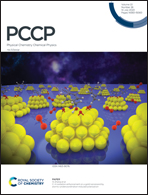Abstract
Chemical dynamics simulations are performed to study the collision induced gas phase unimolecular fragmentation of a model peptide with the sequence acetyl-His1-Cys2-Gly3-Pro4-Tyr5-His6-Cys7 (analogue methanobactin peptide-5, amb5) and in particular to explore the role of zinc binding in reactivity. Fragmentation pathways, their mechanisms, and collision energy transfer are discussed. The probability distributions of the pathways are compared with the results of the experimental IM-MS, MS/MS spectrum and previous thermal simulations. Collisional activation gives both statistical and non-statistical fragmentation pathways with non-statistical shattering mechanisms accounting for a relevant percentage of reactive trajectories, becoming dominant at higher energies. The tetra-coordination of zinc changes qualitative and quantitative fragmentation, in particular the shattering. The collision energy threshold for the shattering mechanism was found to be 118.9 kcal mol−1 which is substantially higher than the statistical Arrhenius activation barrier of 35.8 kcal mol−1 identified previously during thermal simulations. This difference can be attributed to the tetra-coordinated zinc complex that hinders the availability of the sidechains to undergo direct collision with the Ar projectile.



 Please wait while we load your content...
Please wait while we load your content...